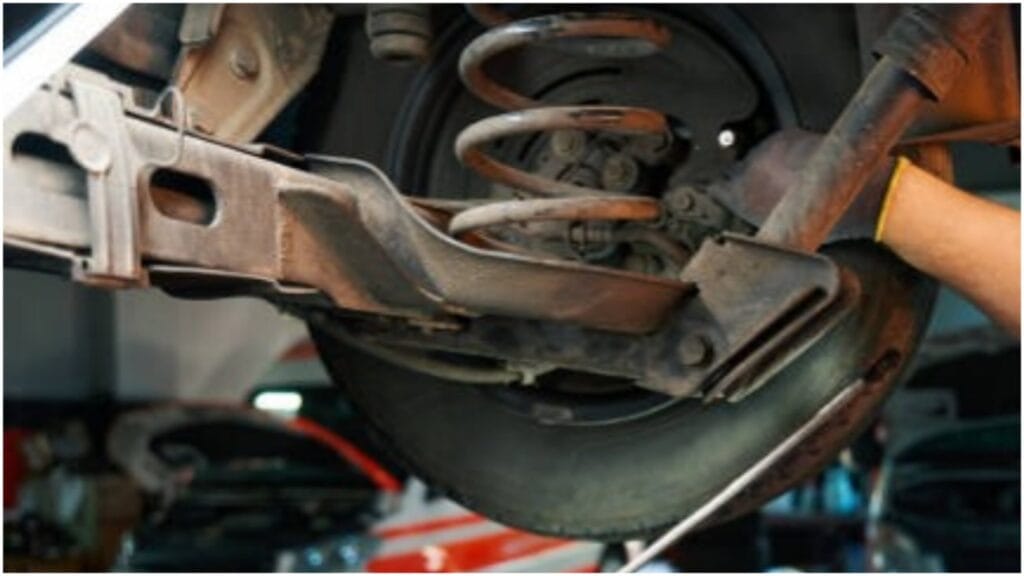To check your car’s suspension, start by visually inspecting the shocks and struts for leaks or damage. Look For any signs of wear, rust, or dents on these components. Next, push down on each corner of the car and release it. The vehicle should bounce once and then return to its normal position.
If the shocks or struts bounce more than once, they may wear out. Another test is to drive over a speed bump or rough road. Pay attention to any unusual noises, like clunking or rattling, which could indicate a problem with the suspension.
Listen for any creaking sounds when turning or making sharp maneuvers. These might indicate issues with bushings or ball joints. Let’s discuss this in more detail.
What is the Suspension Anyway?
Your car’s suspension system isn’t just about comfort—it plays a critical role in keeping you safe. The suspension absorbs shocks from the road, stabilizes the car, and ensures all four tires stay in contact with the surface. This system includes springs, shock absorbers, struts, control arms, and more.
Why You Need to Check It
Suspension problems sometimes make themselves apparent later. In the middle, when you notice something’s wrong, it may be too late to avoid damage. Here’s why you need to stay on top of it:
- Comfort: A well-functioning suspension system makes driving more comfortable. Your car will feel like a trampoline on even the most minor bumps.
- Safety: Your suspension keeps the tires firmly planted on the road. If your suspension fails, you lose traction, especially when braking or turning. This can lead to accidents.
- Preventing Bigger Damage: If one part of your suspension fails, other parts could follow soon after. Ignoring it now could mean more costly repairs later.
- Handling: If you notice your car pulling to one side or you’re having trouble making tight turns, it could be your suspension acting up.
How to Check Your Car Suspension: The Easy DIY Way?

Let’s start with basic checks that don’t require fancy tools or professional knowledge. All you need is time, a keen eye, and a good pair of hands.
Bounce Test
Here’s a simple test you can do yourself—without even having to jack up the car. Stand at the corner of your car and press down hard on the front bumper or rear end. Push the car down, then release it quickly. Does the car bounce up and down a couple of times?
If your car bounces repeatedly, your shock absorbers or struts might be worn out. The suspension should return to its normal position almost immediately after you release the pressure. If it doesn’t, you’ve got a problem.
Listen for Weird Noises
Sometimes, your suspension system can be loud—especially if something’s wrong. Your suspension might be wearing out or misaligned if you hear creaking, clunking, or popping sounds when you turn or go over bumps.
It’s easy to miss, but pay attention if you’re hearing strange noises when you take a sharp turn or hit a bump.
Check for Uneven Tire Wear
Suspension problems often manifest in uneven tire wear. Take a walk around your car and inspect the tires. Are they worn down more on one side than the other? Do you see patches where the rubber looks like it’s been grinding against the road abnormally?
Worn-out suspension components can cause uneven tire wear, especially if the camber or alignment is off. If you notice this, it’s time to examine your suspension and alignment closely.
Look for Leaks
Get under your car and closely examine your shock absorbers and struts. Are there any fluid leaks? This is especially true if you notice puddles underneath your car where you park. Shock absorbers should be dry; any sign of fluid indicates that they aren’t working as they should.
Check for Steering Issues
If your suspension fails, you might feel a difference in how your car steers. If the car pulls to one side or feels hard to steer straight, there could be an issue with the suspension system or related components like the steering rack or control arms. If the wheel feels loose or the car sways more than it should in turns, get it checked out.
Inspect the Springs
Your car’s springs are vital to its suspension system. A broken spring can cause the vehicle to sit unevenly and affect ride quality. Springs usually break due to rust or excessive strain, especially if you’ve been driving on rough roads or carrying heavy loads.
Look under the car for visible signs of damage. You may need to have the car jacked up to get a clear view of the springs, but even a glance can sometimes reveal a broken or sagging spring.
Examine the Control Arms and Bushings
Control arms connect your car’s suspension to the frame, and the bushings are rubber parts that cushion the control arms and prevent metal-on-metal contact. If the bushings are worn out, the control arms can shift or move, causing alignment issues and a rough ride.
Inspect these parts for cracks or signs of wear. If the bushings are cracked or the control arms are loose, that’s a clear sign you need to replace or repair them.
When Should You Seek Professional Help?
While you can perform these checks at home, some suspension issues require professional expertise. If you’ve noticed any of the following, don’t hesitate to take your car to a mechanic:
- You notice your car pulling to one side consistently.
- You hear grinding noises or feel a weird “bump” in the steering wheel.
- There’s a noticeable drop in ride height on one corner of the car.
- The handling feels “loose” or unresponsive.
A mechanic will have the tools to perform more detailed tests, like checking for strut damage or measuring the spring tension. If something is off, it’s better to catch it early before it becomes costly or unsafe.
FAQ’s
Car suspension check:
Checking your car’s suspension is vital for ensuring a smooth ride and safe handling. Start by inspecting the shocks and struts.
Look for signs of wear, such as leaks or damage to the shock absorbers. If they’re worn, the car may bounce excessively or sway more than usual.
Next, check the springs. Over time, springs can weaken or break, affecting the ride height and stability. Ensure there’s no visible damage, and the vehicle sits evenly.
Also, inspect the suspension bushings. These rubber parts can wear out, causing noise or an unstable feeling while driving.
Don’t forget to check the alignment and steering components. Misalignment can lead to uneven tire wear and poor handling. Test drive the car to feel if it pulls to one side or if the steering wheel vibrates.
Finally, look at the tires. Uneven tire wear could be a sign of suspension issues. If you notice any of these symptoms, it’s time for a professional inspection.
Diagnose suspension problems
Suspension problems can appear in several ways. If your car bounces excessively after hitting a bump or feels “loose” when turning, it could mean the shocks or struts are worn out.
When the suspension is off, it affects how the tires grip the road, causing them to wear unevenly. Strange noises, like creaks, clunks, or pops when turning or going over bumps, are also signs that something’s wrong.
If your steering feels heavy or your car pulls to one side, it could indicate suspension or alignment issues. Leaking shock absorbers are another obvious problem, as they should remain dry.
Finally, if the car sits lower on one side or feels unusually stiff, it might be due to broken springs or worn-out control arms. Suspension parts wear out over time, but regular checks can help you catch issues before they worsen.
What is the rear suspension repair cost?
The cost of a rear suspension repair can vary widely depending on your car’s make and model and the extent of damage.
Parts and labor cost between $300 and $1,500. The cost of replacing shock absorbers or struts is generally lower, around $300 to $600.
However, replacing more complex components, such as control arms and springs or a complete suspension rebuild, could cost $1,000 or more.
Labor is a significant part of the price, with some shops charging between $100 and $150 per hour. Luxury or high-performance cars may have higher repair costs due to specialized parts or more labor-intensive procedures.
It’s also important to consider that suspension issues don’t always show up immediately, so repairs may involve diagnosing other linked problems, which could add to the overall cost.
Conclusion
Suspension issues often creep up slowly, but by staying on top of it, you can avoid major headaches down the road. Regular checks, like the bounce test or a quick inspection for leaks, can help you catch problems before they affect your car’s safety and performance.
Keep an eye on your car’s behavior, listen to it, and don’t ignore it if you feel something’s off. This will help you stay in control, keep your tires in touch with the road, and ensure you reach your destination safely.

